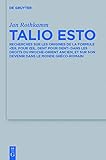Talio Esto : Recherches sur les origines de la formule 'oeil pour oeil, dent pour dent' dans les droits du Proche-Orient ancien, et sur son devenir dans le monde gréco-romain / Jan Rothkamm.
Material type: TextSeries: Beihefte zur Zeitschrift für die alttestamentliche Wissenschaft ; 426Publisher: Berlin ; Boston : De Gruyter, [2011]Copyright date: ©2011Description: 1 online resource (144 p.)Content type:
TextSeries: Beihefte zur Zeitschrift für die alttestamentliche Wissenschaft ; 426Publisher: Berlin ; Boston : De Gruyter, [2011]Copyright date: ©2011Description: 1 online resource (144 p.)Content type: - 9783110264500
- 9783110264517
- 345.394077 22/ger
- K5103
- online - DeGruyter
- Issued also in print.
| Item type | Current library | Call number | URL | Status | Notes | Barcode | |
|---|---|---|---|---|---|---|---|
 eBook
eBook
|
Biblioteca "Angelicum" Pont. Univ. S.Tommaso d'Aquino Nuvola online | online - DeGruyter (Browse shelf(Opens below)) | Online access | Not for loan (Accesso limitato) | Accesso per gli utenti autorizzati / Access for authorized users | (dgr)9783110264517 |
Frontmatter -- Table des matières -- Abréviations -- Introduction -- I. « Tête pour tête » -- II. « Vie pour vie » -- III. « Œil pour œil » -- IV. Le talion dans la Méditerranée au premier millénaire -- Conclusion -- Notes philologiques -- Bibliographie -- Index locorum -- PLANCHES
restricted access online access with authorization star
http://purl.org/coar/access_right/c_16ec
La présente étude cherche à éclaircir le principe du talion à partir de ses premières attestations dans les droits du Proche-Orient ancien. Elle essaie de démontrer que le talion ne se limite pas à une conception pénale, mais qu'il a existé également sous une forme réparatrice. Cette argumentation repose sur une analyse du formulaire du talion, qui interprète les versets bibliques dans le contexte des modèles cunéiformes, et qui s'étend jusqu'aux témoins de la Méditerranée datant des premiers siècles de notre ère. Le talion ressort ainsi comme un principe de justice qui est à l'origine complet et constructif, et qui ne se laisse pas réduire à une notion purement punitive.
This study seeks to clarify the principle of talionic justice beginning with its first historical manifestations in the legal systems of the Ancient Near East. Itattempts to show that talionic justice was not simply a theory of punishment, but also existed as a restorative justice model. The argument for this interpretation of the talionic formula rests on analysis of the salient Biblical verses in the light of the cuneiform models and also utilizes more recent evidence from the Mediterranean region dating from the first centuries of the Christian era. Talionic justice emerges as a complete and constructive principle of justice from the time of its inception, one that cannot be reducedsolely to its punitive elements.
Issued also in print.
Mode of access: Internet via World Wide Web.
In French.
Description based on online resource; title from PDF title page (publisher's Web site, viewed 28. Feb 2023)


